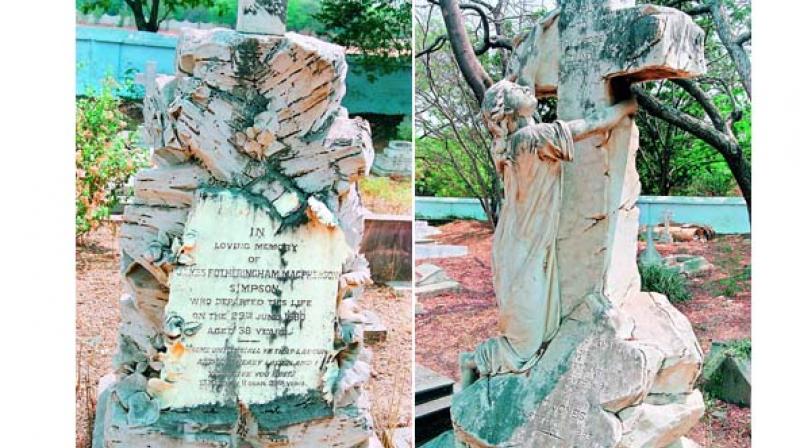British-era epitaphs tell stories of bygone era
St. John's cemetry in Secunderabad sports tombstones dating back to the 1800s.

Hyderabad: In the early 1800s, the British, who made their presence felt in India through the East India Company, were busy spreading their tentacles through a new management technique they called “subsidiary alliance”.
Displaying their military power before rulers of various princely states, they asked them to sign a treaty, a feature of which meant establishment of armed British troops on native soil to “protect” it. In the process, the rulers ceded large chunks of land to the Company, which ultimately became British residencies.
In order to protect himself from his rebels, the Nizam of Hyderabad, too, became an ally of the British, and under the treaty, ceded large tracts of land situated north of Hyderabad, now known as Secunderabad Cantonment.
Secunderabad was under British administration until Independence, and as more and more people attached to the British regiment began settling there, several small churches came up. Many of these old churches still exist and the tombstones from that era in the churchyard often tell interesting stories.
St. John’s Church Cemetery, one of the oldest in Secunderabad Cantonment, holds in its belly tombstones that date back to the second quarter of the 1800s.
There’s a grave of John Henry Desborough of Huntingdon in England who was an officer in East India Company’s Madras regiment and part of Resident Webb’s escort. He died at Baulapur on his way back from Berar where he had gone to meet the Maratha leader Scindia. His large engraved stone is set in a stucco monument.
British soldiers and merchants came to India for a limited stint, to make some money and go back. They were not interested in settling down permanently. Many of them died quickly because of extremities of weather and water. Many of their women and children died young of epidemics. Many of the stones in the graveyard bear testimony to their untimely death.
A stone marked to Ralph Hill Pendlebury says he died of enteric fever at the age of 23. Two girls of a French family died within a year of their arrival, in 1815 and 1816, while a captain, Binny, lost his young wife in 1824.
“Oswell John Hamilton, beloved son of Agnes Lousia and Arthur Charles Leak, called away on 28th August 1914, aged 1 year.” Or “Noel Hubert, infant son of Robert and Clara, aged 3 months on October 21,1896.”
Another very touching epitaph, of Sir W. Gordon’s infant daughter, reads:
“Sweet babe, how short thy stay
How soon thy journey’s over
Thy spirit found a nearer road than thousands
To thy blest abode..”
Some older gravestones are made of scrolls and tombstones of Deccan basalt and granite. They even have a few marble sculptures of kneeling angels and flying fairy queens.
Some stones also record freak accident deaths. For instance, in 1814, an Irish merchant, Luke Rady was thrown off an animal-drawn cart over the tank bund of the historic Hussainsagar.
Most of the early graves are of families of military people, including surgeons, engineers and accountants. The Proudfoot family is marked by a few stones as are several others whose descendants still live in India.
One earliest stone slab that can be read is of an infant Proudfoot, who died in 1842, a child of George and Fanny Proudfoot of the Royal Light cavalry.
“The want of means to raise one as matchless as his worth” regretted the grieving wife of Cumberland John Brindley, Conductor of Ordinance, who passed away in 1824 at the age of 41.
Many interesting epitaphs can be seen here. While the years have taken their toll and some words are illegible, they make us ponder and think about the departed and the mourners. “Until the day breaks and the shadows flee away, blessed are the pure in heart for they shall see God,” runs Ralph Pendlebury’s inscription.
The Holy Trinity Church at Bollaram in Secunderabad cantonment was built in 1847 and has been maintained as per its original plan without modifications. Initially Anglican, it is now a protestant church affiliated to the Church of South India. The small cemetery in its churchyard is as old.
Several memorial plaques dot the walls. Here are a few:
“Robert Charles Aenaes Stuart Lt. Madras regiment died on 21 January 1858 in an encounter with Bheels at Nandagaon.”
Bheels are a prominent tribe in India. What provoked the peaceful tribe is not known. Then there is another inscription marked to Major Herbert Clogston, Victoria Cross. “Commanding officer of the 2nd cavalry, died at Hingoli on 6th of May 1862” probably in a major battle with the Marathas.
Some from the Hyderabad contingent were sent to Burma where they died of diseases, so says a plaque. “Young Lt. Thomas Hardy died while playing polo in December 1938.”
“Lt. Arthur Fagan died trying to save a native boy from drowning on December 23, 1900, never saw Christmas.”
Apart from the soldiers, there are bureaucrats and advisors to the Nizam. Col Cuthbert Davidson, who died in 1862, and one Bushby in 1856.
Some statues on the older gravestones are missing, some broken and buried beneath layers of earth. Only a few remain, faded memorials to the presence of the British in Hyderabad. The graves stand out because of the cold polished granite marbles on them.
The graves do not seem to mean much to Christians of today, most of them having no connection with those buried in the graveyards ages ago. They said the Whites made good use of them but always kept them at a distance. Even services in the church was held separately. It is not clear whether their burials were also earmarked separately.

